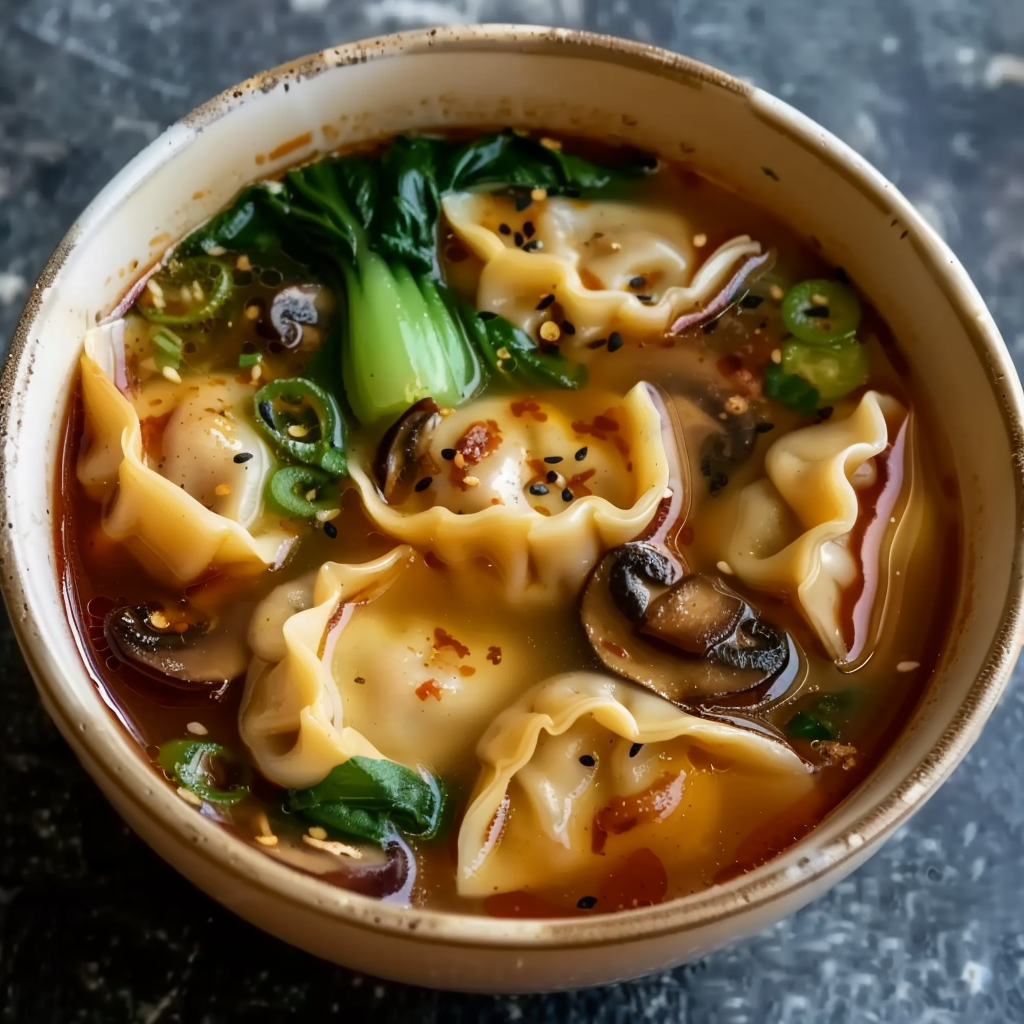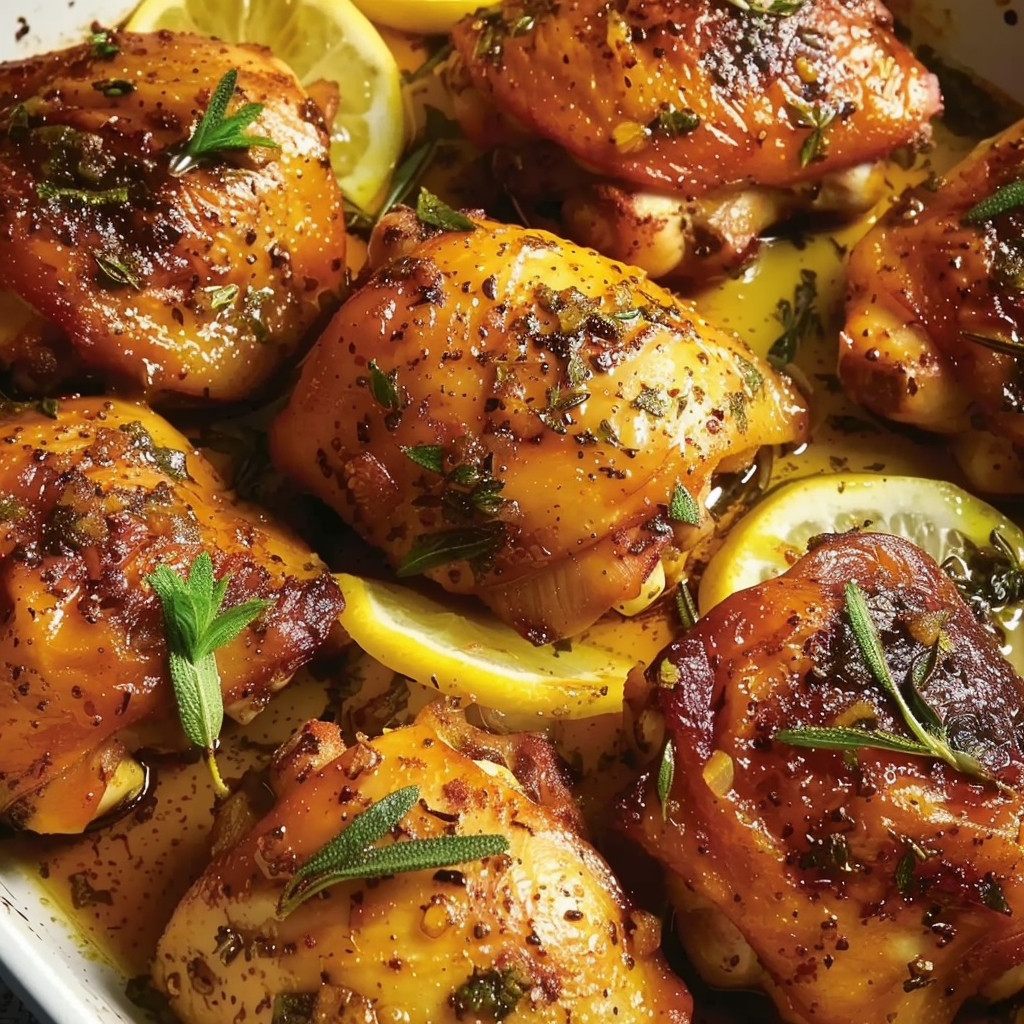Chinese-Style Potsticker Soup
When it comes to easy comfort food that delivers big on flavor without the cleanup, Chinese-style potsticker soup is a perfect solution. It’s a warm, savory bowl filled with dumplings, crisp vegetables, and rich broth—all simmered in just one pot. Inspired by traditional Asian flavors, this soup brings the heart of dumpling cuisine into a quick and accessible weeknight dish.
In many Asian households, dumplings like jiaozi or potstickers are staples, often enjoyed during holidays or family gatherings. This soup is a modern twist on that tradition, combining the satisfying chew of potstickers with the depth of a soy and mushroom-based broth. You’ll find this dish offers the umami richness typical of East Asian cooking, especially when using ingredients like shiitake mushrooms, soy sauce, and sesame oil—common staples in a well-stocked Asian pantry. Learn more about the cultural significance and variations of Chinese dumplings to better understand the dish’s roots.
This recipe is also highly adaptable. Whether you choose vegetarian dumplings, chicken potstickers, or even turkey, the one-pot approach keeps everything simple and cohesive. It shares the same culinary efficiency found in other one-pot meals, offering both comfort and ease—an idea popular on platforms like Pinterest’s one-pot meal inspiration board. The soup also reflects a growing appreciation for Asian comfort food recipes, bridging the gap between homemade convenience and restaurant-style results.
In the next section, we’ll take a closer look at what potsticker soup actually is, and how its unique fusion of dumplings and broth creates one of the most crave-worthy dishes for cool evenings or quick dinners.
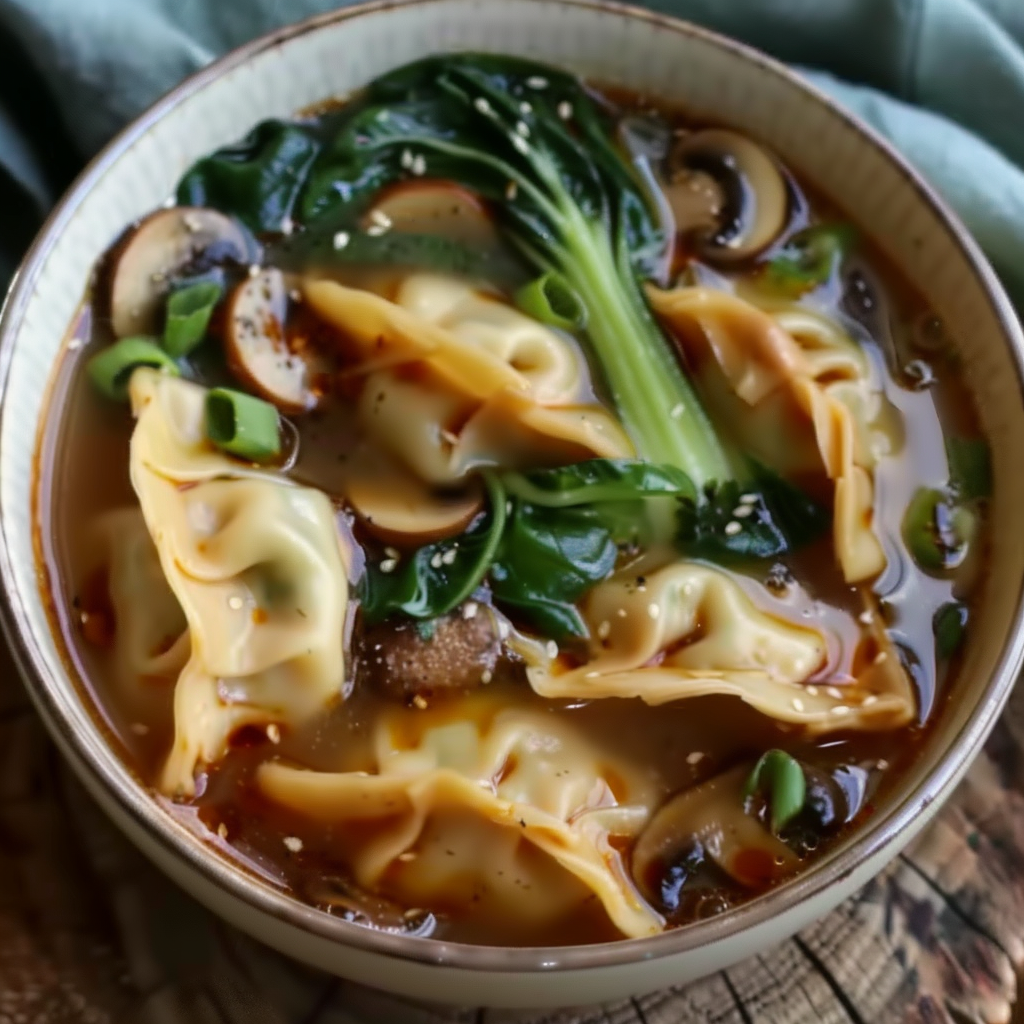
What Is Potsticker Soup?
Potsticker soup is a fusion dish that combines the bold, aromatic qualities of Asian-style broths with the hearty satisfaction of dumplings. At its core, this soup is built around potstickers—pan-fried or boiled dumplings—simmered gently in a flavorful broth, often enhanced with vegetables like bok choy, mushrooms, and fragrant aromatics such as ginger and garlic. The result is a cozy, umami-rich soup that feels both indulgent and nourishing.
Potstickers themselves are a type of Chinese dumpling, traditionally filled with ground meat and vegetables, then pan-fried and steamed. According to Wikipedia’s guide on potstickers, their crispy bottoms and tender tops offer a unique texture that makes them stand out from other dumplings. In soup, these potstickers soften slightly while still retaining their shape and flavor, making them a perfect main component of a broth-based meal.
This dish is part of a broader trend in home cooking that emphasizes simplicity without sacrificing taste. The one-pot soup method not only streamlines the cooking process but also allows the flavors to deepen as everything simmers together. Variants of this dish can be found across East Asia, but the modern, quick version has taken off in Western kitchens thanks to its convenience and satisfying results. A similar concept can be found in gyoza soup or wonton soup, though potsticker soup tends to be heartier due to the size and filling of the dumplings.
If you’re exploring more Asian comfort dishes, this soup pairs well with healthy Asian soup recipes, offering a customizable base that can support everything from miso to chili oil. For those looking to experiment, understanding the difference between jiaozi and gyoza or even how dumplings vary by region can help you personalize your potsticker soup further.
Why One-Pot Meals Are Ideal for Busy Cooks
One-pot meals have become a go-to solution for home cooks who want flavorful, wholesome dishes with minimal mess. In the case of Chinese-style potsticker soup, this method shines by combining all the cooking steps—sautéing, simmering, and finishing—into a single pot, saving time on both prep and cleanup.
This style of cooking is particularly appealing for weeknight meals when time and energy are limited. The layered cooking process—starting with aromatics like garlic, ginger, and the white parts of green onions, followed by mushrooms and broth—builds flavor without requiring multiple pans or complicated techniques. The potstickers are added directly into the broth, gently cooked until tender, creating a hearty, satisfying main dish in under 30 minutes.
Beyond efficiency, one-pot cooking allows for excellent flavor integration. Each ingredient contributes to the overall profile of the soup. For example, shiitake or cremini mushrooms bring an earthy, meaty depth. Learn more about mushroom types and how they enhance dishes from Wikipedia’s mushroom guide. Meanwhile, soy sauce, rice vinegar, and sesame oil provide a balance of salty, tangy, and nutty notes that deepen as they simmer. Check out soy sauce basics to better understand its role in building Asian-style broth complexity.
There’s also a strong community interest in quick, healthy meals that don’t compromise flavor. On Pinterest, you’ll find endless variations of one-pot recipes, especially those inspired by Asian flavors. These dishes fit neatly into modern lifestyles, offering comfort and nutrition without the fuss. Chinese-style potsticker soup is a prime example—simple, flexible, and full of flavor, all in one pot.
Ingredient Spotlight
Creating a deeply flavorful Chinese-style potsticker soup starts with understanding its essential ingredients. Each component brings texture, aroma, and depth to the final dish, transforming a simple broth into a restaurant-quality meal you can prepare at home. Below is a breakdown of the key ingredients that make this soup both satisfying and versatile.
Potstickers (Frozen or Fresh)
Potstickers are the star of this dish. Whether you use chicken, turkey, pork, or vegetarian potstickers, they provide a hearty, protein-rich element. For convenience, frozen dumplings are ideal—they cook directly in the broth and absorb the soup’s flavors. For best results, choose dumplings with sturdy wrappers that won’t fall apart in simmering liquid. The method of boiling dumplings directly in the broth mirrors cooking techniques used in wonton soup and is explained further in this potsticker cooking guide.
Mushrooms
Mushrooms give the soup a deep, earthy base that enhances the umami quality of the broth. Varieties like shiitake, cremini, or oyster mushrooms work especially well. They soak up flavors while also releasing their own savory richness. According to Wikipedia’s mushroom overview, these fungi are prized not only for their taste but also for their health benefits, including B vitamins and antioxidants.
Bok Choy
This leafy green vegetable adds a refreshing crunch and slight bitterness that balances the richness of the broth and dumplings. Baby bok choy is ideal for this recipe because of its tender leaves and mild flavor. It cooks quickly, so add it near the end of the simmering process to keep it crisp-tender. You can learn more about its nutritional profile and uses from Wikipedia’s bok choy page.
Aromatics: Ginger, Garlic & Green Onions
These ingredients form the aromatic base of the soup. Fresh ginger adds brightness and warmth, while garlic offers a savory depth. The white parts of green onions are sautéed at the beginning, and the green parts are reserved for garnish, giving the dish both visual appeal and fresh flavor.
Flavorings & Condiments
A combination of soy sauce, rice vinegar, and sesame oil seasons the broth. These pantry staples work together to create a complex base that’s salty, tangy, and nutty. Sesame oil uses and soy sauce basics explain how these ingredients are traditionally used in Asian cuisine. For those who enjoy heat, a spoonful of chili garlic sauce or a dash of white pepper can elevate the spice level without overpowering the other flavors.
By thoughtfully combining these ingredients, you get a soup that’s layered, nourishing, and distinctly comforting—perfect for cozy nights or quick meals that don’t compromise on taste. For visual inspiration and alternative presentations of this dish, explore similar versions on Pinterest’s dumpling soup board.
Step-by-Step Instructions with Cooking Tips
Crafting a flavorful Chinese-style potsticker soup doesn’t require hours in the kitchen. In fact, this recipe is designed to be quick and efficient—yet deeply satisfying. With just one pot and a handful of steps, you’ll create a soup that tastes like it came from your favorite Asian restaurant. Follow this step-by-step process, along with helpful cooking tips, to ensure perfect results every time.
Step 1: Heat the Aromatics
-
Begin by heating 1 tablespoon of sesame oil in a large pot over medium heat.
-
Add the white parts of 3 sliced green onions, 2 minced garlic cloves, and 1 tablespoon of fresh grated ginger.
-
Sauté for about 1 minute, just until fragrant. Be careful not to let the garlic brown.
This trio of aromatics creates the flavorful foundation of the broth. Learn more about how sesame oil enhances Asian recipes on Wikipedia.
Step 2: Add Mushrooms
-
Stir in 8 oz of sliced shiitake or cremini mushrooms.
-
Cook for 4–5 minutes, allowing them to soften and release their moisture.
Mushrooms are a key element in building a rich umami flavor. They also add a meaty texture without the need for additional protein.
Step 3: Pour in the Broth and Seasonings
-
Add 4 cups of low-sodium chicken or vegetable broth.
-
Stir in 2 tablespoons of soy sauce, 1 teaspoon of rice vinegar, and 1 teaspoon of chili garlic sauce (optional for heat).
Bring the mixture to a gentle simmer. These flavorings form the backbone of your soup. Explore more about the role of soy sauce in Asian cuisine to understand its versatility.
Step 4: Add Potstickers
-
Gently place 6–8 frozen or fresh potstickers into the pot.
-
Simmer according to package directions (usually 5–7 minutes), until cooked through.
Avoid stirring too much, as this may break the dumplings. Cooking dumplings directly in broth is common in many Asian soup recipes, as seen on Pinterest’s Asian comfort food recipes board.
Step 5: Add Bok Choy
-
Stir in 2 cups of chopped baby bok choy.
-
Simmer for another 2–3 minutes, just until the greens are wilted but still vibrant.
Adding bok choy at the end preserves its fresh crunch and bright color. For more health benefits and cooking ideas, refer to Wikipedia’s bok choy guide.
Step 6: Final Seasoning and Serve
-
Taste the broth and adjust seasoning with salt and pepper, if needed.
-
Ladle the soup into bowls and garnish with fresh cilantro or the green parts of the sliced green onions.
This final touch adds freshness and color, enhancing both presentation and taste.
Cooking Tips:
-
Use low-sodium broth to control saltiness, especially when using soy sauce.
-
For a vegetarian version, use veggie broth and plant-based dumplings.
-
To avoid overcooked dumplings, don’t let the soup boil vigorously after adding them.
For more serving ideas or to explore visual plating styles, see Pinterest’s dumpling soup presentations, where variations with tofu, miso, and noodles are also featured.
With these steps, you’ll have a steaming bowl of one-pot potsticker soup on the table in no time—flavor-packed, warming, and satisfying with every spoonful.
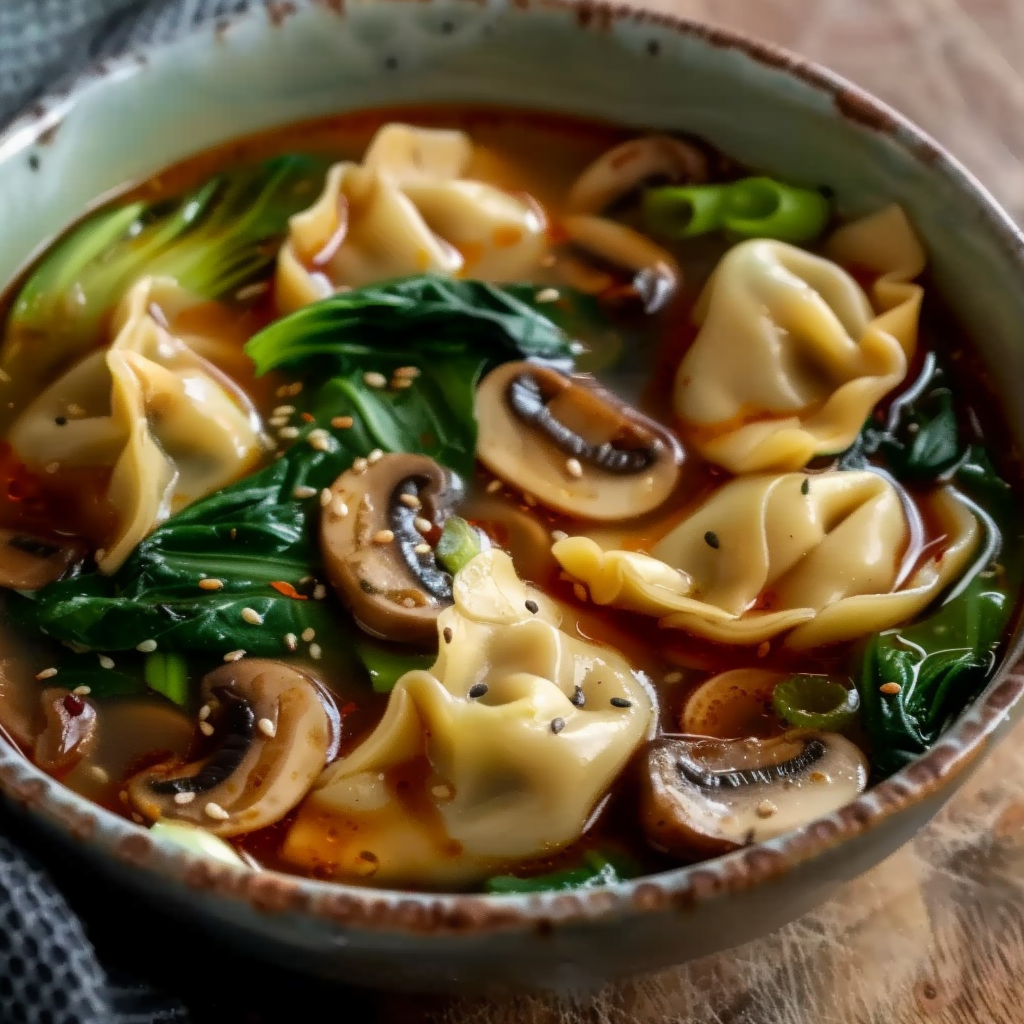
Flavor Variations and Add-Ons
One of the best things about Chinese-style potsticker soup is its flexibility. This comforting dish is easily customizable to suit different tastes, dietary preferences, and seasonal ingredients. With just a few simple swaps or additions, you can transform the basic recipe into something new while keeping it delicious and balanced.
Add-In Ideas:
-
Tofu: For a plant-based protein, add cubed firm tofu during the last 5 minutes of cooking. It absorbs the flavorful broth and provides a nice textural contrast.
-
Spinach or Napa Cabbage: Swap bok choy for these tender greens for a more delicate flavor and softer bite.
-
Miso Paste: Stir in a tablespoon of white or red miso paste to the broth for added depth and fermented complexity.
-
Bean Sprouts: Add right before serving for a crunchy, fresh element.
Boost the Spice:
-
Add a few drops of chili oil, a spoonful of Sambal Oelek, or thin slices of fresh chili peppers if you love heat.
-
A pinch of white pepper can also add warmth without overpowering the soup.
Broth Variations:
-
Use bone broth for an extra rich and nourishing base.
-
Try a miso-dashi combo to bring in Japanese influences.
Dumpling Swaps:
-
Instead of potstickers, use gyoza, wontons, or even handmade dumplings. Learn more about the differences between dumpling types by browsing Chinese dumpling varieties.
These flavor tweaks allow you to make the soup your own. Find more ideas for customizing Asian soup dishes on Pinterest’s healthy Asian soup board where home cooks share their creative spins
Serving Suggestions & Pairings
While potsticker soup can easily stand on its own as a complete meal, it pairs beautifully with other light sides or beverages that complement its Asian flavor profile.
Garnishes:
-
Cilantro leaves for freshness
-
Green onions for mild onion flavor
-
Toasted sesame seeds for crunch and aroma
Suggested Side Dishes:
-
Steamed jasmine rice or brown rice to soak up the broth
-
Scallion pancakes for a crispy bite on the side
-
Asian slaw with sesame dressing for a crunchy contrast
Drink Pairings:
-
Jasmine tea or green tea to cleanse the palate
-
Chilled sake or light white wine for an elegant touch
Explore similar serving pairings through Pinterest’s Asian comfort food recipes for visual inspiration and ideas.
Storage and Reheating Tips
Leftovers of this soup store well, but keeping the texture of the dumplings and vegetables intact requires a few key techniques.
Refrigeration:
-
Store in an airtight container in the fridge for up to 3 days.
-
For best results, separate the dumplings from the broth and veggies before storing. This prevents them from becoming soggy.
Reheating:
-
Warm the broth and vegetables on the stove over medium heat.
-
Add the dumplings back into the pot during the last 2–3 minutes to gently reheat without overcooking.
-
Avoid microwaving the dumplings for too long—they can fall apart or become rubbery.
Freezing Tips:
-
Not recommended to freeze the full soup with dumplings.
-
Instead, freeze the broth separately and add freshly cooked dumplings when reheating.
These steps ensure your soup retains its texture and flavor even after storing. For best results, consume the leftovers within a couple of days.
Nutrition Benefits
This one-pot soup is not just comforting—it’s also nourishing. With lean protein, vegetables, and a light broth, it checks all the boxes for a balanced meal.
Nutritional Highlights:
-
High in Protein: From dumplings and/or tofu
-
Rich in Vitamins: Thanks to bok choy and mushrooms
-
Low in Fat: Especially if using a light broth and lean protein dumplings
-
Low Sodium Option: Use low-sodium soy sauce and broth to keep salt in check
To further improve nutrition, explore adding more vegetables or using whole grain dumplings if available. Learn more about bok choy’s health benefits through Wikipedia’s bok choy page.
Common Mistakes to Avoid
Even a simple soup can go wrong without a few best practices. Here are common pitfalls and how to avoid them:
-
Overcooking Dumplings: Once they’re tender and floating, they’re done. Overcooking can cause them to split open.
-
Boiling Too Hard: Simmer gently to keep everything intact. A vigorous boil may break apart dumplings and turn vegetables mushy.
-
Sautéing Aromatics Too Long: Garlic burns fast. Keep an eye on your aromatics in the first minute of cooking.
-
Adding Greens Too Early: Add bok choy only at the end to keep it vibrant and slightly crisp.
-
Using Salty Broth and Soy Sauce Together: Stick to low-sodium versions so you can control seasoning.
Avoiding these mistakes helps ensure a soup that’s perfectly seasoned, well-textured, and restaurant-worthy.
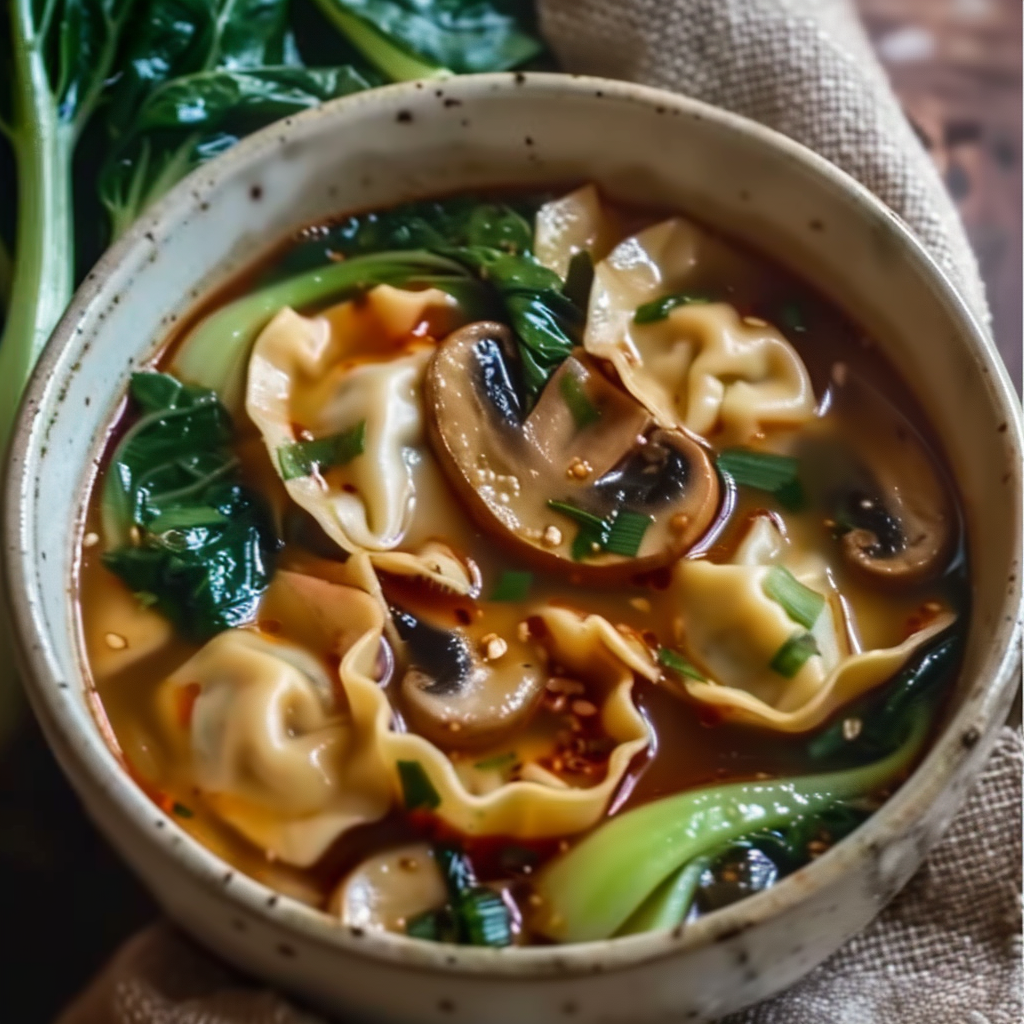
FAQs
Can you boil potstickers directly in soup?
Yes, you can add potstickers straight into the simmering broth. Just ensure the soup isn’t boiling too hard, or the dumplings may break apart. Follow package directions for cook time.
What’s the difference between dumplings and potstickers?
Potstickers are a type of Chinese dumpling typically pan-fried on one side and then steamed. Dumplings is a broader term that can include boiled, steamed, or fried varieties with different fillings and wrappers. Learn more from Wikipedia’s dumpling article.
Can you use frozen dumplings for soup?
Absolutely. Frozen dumplings are perfect for this recipe—just drop them into the broth and simmer until heated through. No need to thaw first.
What broth is best for Asian dumpling soups?
A low-sodium chicken or vegetable broth is ideal. For deeper flavor, try miso broth, dashi, or even bone broth for added nutrition.
How do you make potsticker soup vegetarian or vegan?
Use vegetable broth and plant-based potstickers. Also check the wrapper ingredients to ensure they’re egg-free if going fully vegan. Add tofu for extra protein.
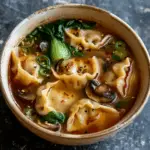
Chinese Style Potsticker Soup Easy One Pot Comfort Food
- Author: Naomi
Description
This Chinese-style potsticker soup is an easy, one-pot comfort food packed with bold Asian flavors. Featuring juicy dumplings, earthy mushrooms, crisp baby bok choy, and a fragrant soy-ginger broth, it comes together in under 30 minutes. Ideal for cozy nights or quick dinners, this satisfying soup delivers restaurant-quality flavor with minimal cleanup.
Ingredients
- 1 tablespoon sesame oil
- 3 green onions, sliced (white and green parts separated)
- 2 cloves garlic, minced
- 1 tablespoon fresh ginger, grated
- 8 oz mushrooms, sliced (such as shiitake or cremini)
- 4 cups low-sodium chicken or vegetable broth
- 2 tablespoons soy sauce
- 1 teaspoon rice vinegar
- 1 teaspoon chili garlic sauce (optional, for heat)
- 6–8 turkey or chicken potstickers (frozen or fresh)
- 2 cups baby bok choy, chopped
- Salt and pepper to taste
- Fresh cilantro or additional green onions, for garnish
Instructions
Heat sesame oil in a large pot over medium heat. Add the white parts of the green onions, garlic, and ginger. Sauté until fragrant, about 1 minute.
Add the sliced mushrooms and cook until they begin to soften, about 4–5 minutes.
Pour in the broth, soy sauce, rice vinegar, and chili garlic sauce (if using). Bring to a gentle simmer.
Carefully add the potstickers to the soup. Simmer until they are heated through and cooked (if using frozen, follow package directions), about 5–7 minutes.
Add the chopped bok choy and cook for another 2–3 minutes, until just wilted.
Taste and adjust seasoning with salt and pepper if needed.
Serve hot, garnished with cilantro or the green parts of the sliced green onions.
Notes
-
Use low-sodium broth and soy sauce to better control saltiness.
-
Add potstickers directly from frozen—no need to thaw.
-
For added spice, stir in chili garlic sauce or top with chili oil.
-
Fresh ginger and garlic are key to the broth’s aromatic base—don’t skip them.
-
To keep bok choy vibrant, add it only in the final minutes of cooking.
-
Separate dumplings from broth before refrigerating to avoid sogginess.
-
Pair with a side of jasmine rice or scallion pancakes for a heartier meal.
-
Explore different mushroom types or dumpling fillings for variety.


